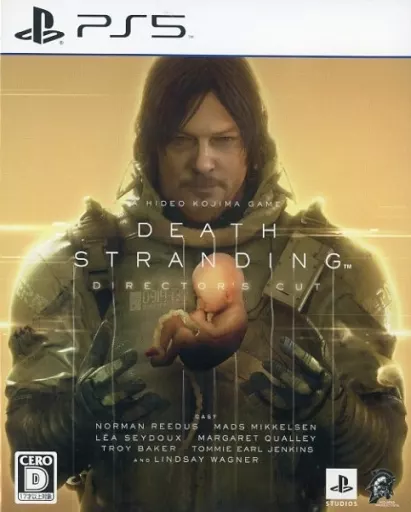死亡擱淺 導演剪輯版
《Death Stranding Director’s Cut》(日文名稱:デス・ストランディング DIRECTOR’S CUT)是由小島秀夫(Hideo Kojima)主導開發、Kojima Productions 製作的PS5強化版遊戲,是2019年原版《Death Stranding》的進化版本。於2021年9月24日登陸PlayStation 5,包含原本完整的劇情與遊戲內容外,更透過PS5主機的硬體性能全面升級畫質、幀率與沉浸式操作,同時追加新關卡、新任務、新裝備與更多玩法選項,讓新舊玩家都能以全新方式體驗這部獨特的作品。
故事背景依舊設定在人類社會因「死亡擱淺」現象而分崩離析的未來。主角山姆‧波特‧布橋斯(Sam Porter Bridges)是一位「送貨人」,被委託橫跨美國大陸,將被孤立的生還者社區重新連接至「開羅網絡」(Chiral Network),以重建社會聯繫與秩序。在這場旅途中,他不僅與神秘的超自然現象「BTs」對抗,也一步步揭開災難的真相與自身的過去。這段劇情充滿哲學色彩與情感張力,探討孤獨、連結、生死、科技與人類關係,融合懸疑與深層敘事,是整體體驗中最具靈魂的部分。
導演剪輯版的最大特色之一,是針對遊戲機制的優化與補強。原版中部分玩家認為送貨過程略顯冗長與重複,因此新版加入許多改善工具與系統,例如貨物彈射器、支援機器人、自動運輸車輛、跳躍平台等,讓運輸過程更加高效而富娛樂性。同時,這些新增裝備的設計依然不違背遊戲原本的主題與氛圍,維持「人在自然中掙扎與連結」的核心體驗。
除主線優化外,亦新增多項支線任務與特殊區域。其中最令人驚喜的是潛入設施的任務,需潛行於敵方基地,藉此向小島過去的經典系列《潛龍諜影》(Metal Gear Solid)致敬,營造出熟悉的緊張氣氛與策略感。此外,還有競速賽道模式,駕駛送貨車輛在專屬賽道中計時競速,這些內容為原本沉重的氛圍注入一絲輕鬆與趣味。
畫面表現方面,透過PS5硬體實現4K解析度、高幀率模式、HDR優化與更細緻的紋理處理,大幅提升視覺沉浸感。加上DualSense控制器的觸覺回饋與自適應扳機技術,能實際感受到不同地形的腳步阻力、載具震動、甚至武器開火時的扳機反饋,使得每一次行走與互動都變得更加真實與緊湊。
在市場評價方面,整體獲得高度肯定。許多原本對原版節奏抱持保留意見的玩家,因新版的優化機制而重新投入遊戲。而喜愛原版的玩家則對追加內容與更豐富的敘事支線感到滿意。遊戲評論媒體普遍認為,導演剪輯版是對原作精神的深化與完善,不僅更具可玩性,也更易於被新玩家接受。同時被認為是融合電影敘事、哲學思辨與遊戲創新的實驗型代表作,是當代最具藝術氣質與開創性的遊戲之一。
總結來說,《Death Stranding Director’s Cut》不只是原作的高清重製或技術強化,而是更完整的創作表達。對人類孤獨與連結的思索,透過遊戲作為敘事媒介潛力的深度探索,也是小島秀夫「Strand Game」理念的集大成。對於那些尋求不同節奏與深度內容的玩家來說,這不只是遊戲體驗,而是一趟關於存在與情感的旅程。
“Death Stranding” (Japanese title: デス・ストランディング) is a groundbreaking action game developed by Kojima Productions, the studio founded by Hideo Kojima after his departure from Konami. It was published by Sony Interactive Entertainment and released on November 8, 2019, for the PlayStation 4. The game marked Kojima’s first original creation following the legendary Metal Gear series and sparked widespread discussion among the gaming community and industry due to its distinctive gameplay and profound thematic content.
Set in a post-apocalyptic future, the game’s narrative unfolds in a world devastated by a mysterious phenomenon known as the “Death Stranding.” This cataclysm has shattered the boundary between life and death, allowing supernatural entities called “BTs” (Beached Things) to invade the real world. Death itself has become explosive, triggering destructive events known as “voidouts.” The remnants of humanity have taken refuge in isolated cities and shelters, with the once-unified nation now fragmented and cut off. In this bleak landscape, players assume the role of Sam Porter Bridges, a porter tasked with traversing the fractured lands of America. His mission is to reconnect the scattered communities through a digital network known as the “Chiral Network,” with the ultimate goal of restoring societal cohesion and communication.
In terms of gameplay, Kojima coined the term “Strand Game” to describe Death Stranding, emphasizing the core theme of “connection.” Unlike traditional action games that focus on combat or shooting, this game revolves around traversal and delivery. Players spend the majority of the game navigating treacherous natural terrain, transporting supplies and critical technologies to various outposts. The mechanics require careful attention to cargo balance, path planning, and equipment choice, as players must overcome rivers, cliffs, storms, and enemy threats such as the BTs and MULEs—rogue couriers obsessed with hoarding packages. While the premise may sound monotonous, the gameplay is layered with strategic depth through systems like weight management, bridge building, exoskeletons, terrain mapping, and weather forecasting, making the overall experience surprisingly rewarding.
A major innovation lies in the game’s asynchronous multiplayer system. Players can construct ladders, ropes, power generators, and roads in their own game world, which may then appear in other players’ worlds. These contributions can be used and “liked” by others, fostering a subtle yet powerful sense of community and cooperation. The idea of connecting people through shared effort—without ever meeting face to face—is a central message that transcends the gameplay itself.
Narratively, Death Stranding blends philosophical inquiry, science fiction, and deeply emotional storytelling. Its characters are richly developed, led by Norman Reedus as Sam, a courier burdened by emotional trauma. His bond with the enigmatic infant “BB” (Bridge Baby) forms the emotional backbone of the story. Performances by Léa Seydoux, Mads Mikkelsen, and Lindsay Wagner further enhance the immersive quality of the narrative. The game explores boundaries between life and death, isolation and connection, presenting a haunting meditation on human relationships amid catastrophe. Its conclusion offers no simple answers but leaves players with a poignant mix of hope and melancholy, encouraging deep reflection.
Reception to Death Stranding was highly polarized. Many praised it as a bold artistic achievement that pushed the boundaries of the medium, seamlessly integrating narrative, gameplay, and thematic exploration. Critics lauded the game’s visual fidelity, atmospheric soundtrack (featuring contributions from bands like Low Roar), motion capture performances, and ambitious conceptual design. It earned numerous accolades and nominations for Game of the Year. On the other hand, some players criticized the slow pacing and repetitive mechanics, dubbing it a “delivery simulator,” and noted that its unconventional structure might not appeal to action-oriented gamers.
In conclusion, Death Stranding defies genre conventions and challenges player expectations. It eschews adrenaline-driven excitement in favor of themes such as loneliness, interdependence, labor, and redemption. It tells a story not just of surviving, but of healing, reconnecting, and rebuilding. While it may not resonate with everyone, it stands as one of the most inventive and daring games of the early 2020s, solidifying its place as a work of interactive art that explores the full potential of video games as a storytelling medium.
運費計算方式:
貨款滿1000元運費外加90元
貨款1000以下:買1件運費外加 60元,買2件運費外加 70元,
買3件運費外加 80元 ,買4件運費外加 90元
貨到付款外加30元手續費
外島及大陸地區運費另計
付款方式:
線上刷卡:本站採用Paypal線上刷卡
虛擬帳號匯款:屬於您專屬的虛擬帳戶,方便站長查帳使用,本站強力推薦
實體ATM匯款:請將匯款帳號記錄下來至各大銀行ATM提款機轉帳
超商條碼繳費:請列印本站提供的條碼至四大超商繳費
線上轉帳:透過玉山銀行線上ATM轉帳(此系統只支援IE瀏覽器)
貨到付款:本站採用黑貓宅急便貨到付款
其他注意事項:
如需購買線上點數卡請直接跟站長連絡,本站不提供點數卡的線上付款
-
死亡擱淺 導演剪輯版
- 定 價: 6,490円
- 售 價: 0.00
- 庫存量: 0 套
- 已賣出: 0 套
 人氣指數: 0.4 / 6 顆星
人氣指數: 0.4 / 6 顆星

